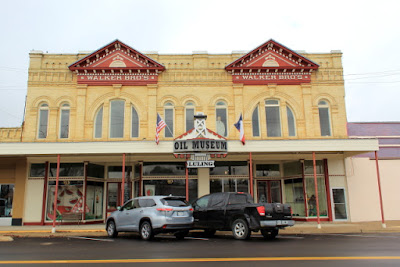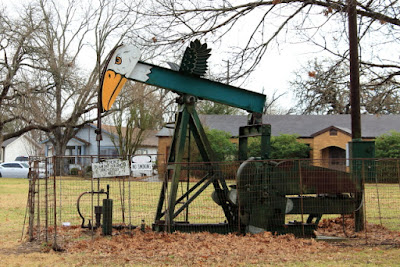Friday, March 9, 2018
RonnieAdventure #0298 - Texas 2018, Part V
Luling (population 5,411) was founded in 1874 when the railroad intersected a main wagon road. Cowboys from cattle drives on the Chisholm Trail and drifters soon filled the town and Luling became known as "The Toughest Town in Texas." However, the cattle drives ended in the 1880s and Luling became just another small town that served the local farmers and ranchers.
Then, on August 9, 1922, Edgar B. Davis struck oil near Luling. The oil field was 12 miles long and 2 miles wide. Luling's economy quickly changed from ranching and farming to oil production, and the town's population increased from 1,500 to over 5,000 people almost overnight.
Today, the historic Walker Brothers Building has been converted into an oil museum and some of the old town buildings have been replicated in the museum.
Oil wells are located throughout the town and some of the pump jacks have been decorated as animated art objects.
City Market is known as one of the best barbeque restaurants in Texas, and after stuffing ourselves we agreed with the rating.
Zedler Mill was built in 1874 as a grist mill and sawmill, but a few years later a cotton gin was also constructed on the site. The mills closed in the 1960s and the facilities are now preserved as a historical site.
The William Johnson Cabin was built in the 1870s and the Reverend Johnson raised his family of five children in the shotgun-style cabin.
Lockhart (population 12,698) was named the "Barbecue Capital of Texas" by the Texas Legislature, but we still rate City Market in Luling as #1.
The Caldwell County Courthouse was constructed in 1894 using Muldoon Limestone with Red Pecos Sandstone trim and has been referred to as "ugly enough to be beautiful." Parts of numerous movies have been filmed in Lockhart, using the courthouse as a backdrop.
The Southwest Museum of Clocks & Watches is located across the street from the courthouse, but the museum was closed the day we visited Lockhart.
Giddings (population 5,168) was founded in 1871 on lands that were originally part of the Stephen F. Austin Land Grant. Early settlers were mostly Wendish immigrants. Historic signs indicate that the Notorious outlaw Bill Longley was hanged in Giddings on October 11, 1878.
After the original Lee County Courthouse burned down, it was replaced in 1899 with the current building that was constructed in Richardson Romanesque style architecture using octagonal red-bricks.
Directly across the street from the courthouse is the Lee County Heritage Center that is housed in the 1879 Schubert-Fletcher home. The center contains a variety of artifacts, photos, and other items on the history of Lee County.
Caldwell (population 4,104) has been named the "Kolache Capital of Texas" by the Texas Legislature. We missed the annual Kolache Festival, but we did see the "Memorial to Agriculture." There is a plaque at the base of the sculpture stating: "The centerpiece is the master condenser from the Vykukal Cotton Gin that was active on this site for many years. The two faces atop the condenser represent the different ethnic races who toiled in the fields to produce the crops. Each of the columns that encircle the Memorial is crowned with a farm implement of days gone by."
Rockdaale (population 5,439) has one of the three sanctioned horse training tracks in Texas, located just north of town at Valhalla Farms. The town was named after a rock that stood 12 feet high and had a circumference of 20 feet.
Cameron (population 5,634) was founded in 1846 when the town-site was purchased for the permanent location of the Milam County seat. However, the new town struggled because of its isolated location with the closest railroad over 50 miles away. In 1850 an attempt was made to bring a steamboat up the Little River, and the boat made it withing 2.5 miles of town; but it was determined that steamboat service was not a feasible mode of transportation for the area because there was typically not enough water in the river. Many people wanted to move the county seat to Rockdale where there were better transportation services, but twice the move was voted down. Finally, in 1881 the Gulf, Colorado and Santa Fe Railway made it to Cameron, which helped the area grow by about 60%.
While I was wandering through the courthouse, I located the old county safe in the basement. I do not know if anything was in the safe because the door was locked and I could not find the combination.
In front of the building is a statue of Old Ben Milam, who was a leader in the Texas Revolution and the person that persuaded the Texians not to back down in the Siege of Bexar (now San Antonio). While leading the assault, he was killed in action.
Hearne (population 4,459) is known as "The Crossroads of Texas" because it is located at the junctions of highways US 79, US 190, and Texas 6, along with the crossing of state's major east-west and north-south rail lines. During WW II, Hearne was the site of a German Prisoner-of-War camp.
Franklin (population 1,564) was originally settled in 1872 using the name "Morgan." However, everyone in the county knew the area as "Old Franklin," so the town's name was changed to "Franklin." The ornate Robertson County Courthouse was constructed in 1881 and the county jail, located behind the courthouse, is constructed of similar materials.
Subscribe to:
Post Comments (Atom)




































No comments:
Post a Comment